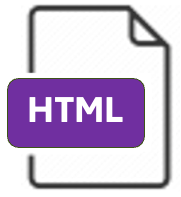HTML (Hypertext Markup Language)

HTML files can be viewed as a web page within your web browser (i.e., Firefox or Chrome). They include navigation through a Table of Contents, web links and alternate text for pictures and graphics. These AIM-VA HTML files have been converted from files book publishers have placed on the NIMAC website. They can be used with browser extensions that make reading more accessible.
Accessibility Features HTML
- Compatible with text-to-speech extensions
- Reflowable text optimized to fit on the page regardless of font size
- Can be opened in any web browser, with or without internet access
- Electronic navigation
- Page numbers correspond to the page numbers of the printed text if programmed by the publisher
Compatible programs that work with HTML
- Web browsers such as Google Chrome, Mozilla Firefox, Microsoft Edge, and Safari
- Browser apps and extensions such as Read&Write and Snap&Read
- Chromebook readers such as Select-to-Speak and ChromeVox.
- A text editing program such as Notepad in MicroSoft.
Teaching Strategies for use with HTML
- Teach students to use an extension in the browser that reads the file to them such as:






